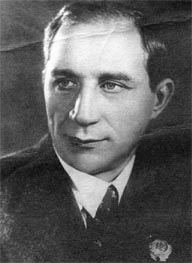Name Eduard Tisse | Role Cinematographer | |
 | ||
Movies Battleship Potemkin, ¡Que viva Mexico!, October: Ten Days That Sho, Strike, Alexander Nevsky Similar People Grigori Aleksandrov, Sergei Eisenstein, Aleksandr Antonov, Edmund Meisel, Nina Agadzhanova | ||
Eduard tisse s cinematography october
Eduard Kazimirovich Tisse (Russian: Эдуа́рд Казими́рович Тиссэ́, Latvian: Eduards Tisē; 13 April 1897, – 18 November 1961) was a Soviet cinematographer.
Contents
- Eduard tisse s cinematography october
- ONE FILM ONE SHOT 48 Ivan the Terrible Part 1
- Early life and career
- Selected filmography
- References
ONE FILM / ONE SHOT #48: Ivan the Terrible, Part 1
Early life and career
He was born to a Estonian Swedish father and Russian mother in Liepāja; he grew up in Liepāja and studied both painting and photography.
He started his career in 1914 as a newsreel cameraman during the Russian Civil War. From 1916 to 1918, he worked as a military cameraman. In 1921, Tisse became a professor at Gerasimov Institute of Cinematography. His career didn't take off until working with director Sergei Eisenstein on the film Strike. Tisse would become Eisenstein's standard cinematographer for the next twenty years.
Tisse, along with Eisenstein and Grigori Alexandrov went on a trip in 1929. They traveled to Europe and the United States with the intent of finding new sound equipment and creating connections between Hollywood and the Soviet film industry. Eisenstein signed with Paramount Pictures and trio headed to California. They worked on several pictures, but nothing was actually produced. Through Eisenstein, photojournalist Margaret Bourke-White met Tisse and in 1932, collaborated with her on Eyes on Russia (1933); this would be Bourke-White's only attempt at film making.
In 1942, Tisse worked on the film In The Mountains of Yugoslavia with soviet filmmaker Abram Room. The film focused on the character Slavko Babic, his life and death, as well as, the Yugoslav-Persian liberation during World War II. The film proved to be very influential for future Yugoslav filmmakers.
His favorite camera was the Debrie Parvo, which he continued to use even during the sound era to film silent sequences.
